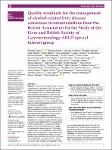Quality standards for the management of alcohol-related liver disease: consensus recommendations from the British Association for the Study of the Liver and British Society of Gastroenterology ARLD special interest group
| dc.contributor.author | Parker, R | |
| dc.contributor.author | Allison, M | |
| dc.contributor.author | Anderson, S | |
| dc.contributor.author | Aspinall, R | |
| dc.contributor.author | Bardell, S | |
| dc.contributor.author | Bains, V | |
| dc.contributor.author | Buchanan, R | |
| dc.contributor.author | Corless, L | |
| dc.contributor.author | Davidson, I | |
| dc.contributor.author | Dundas, P | |
| dc.contributor.author | Fernandez, J | |
| dc.contributor.author | Forrest, E | |
| dc.contributor.author | Forster, E | |
| dc.contributor.author | Freshwater, D | |
| dc.contributor.author | Gailer, R | |
| dc.contributor.author | Goldin, R | |
| dc.contributor.author | Hebditch, V | |
| dc.contributor.author | Hood, S | |
| dc.contributor.author | Jones, A | |
| dc.contributor.author | Lavers, V | |
| dc.contributor.author | Lindsay, D | |
| dc.contributor.author | Maurice, J | |
| dc.contributor.author | McDonagh, J | |
| dc.contributor.author | Morgan, S | |
| dc.contributor.author | Nurun, T | |
| dc.contributor.author | Oldroyd, C | |
| dc.contributor.author | Oxley, E | |
| dc.contributor.author | Pannifex, S | |
| dc.contributor.author | Parsons, G | |
| dc.contributor.author | Phillips, T | |
| dc.contributor.author | Rainford, N | |
| dc.contributor.author | Rajoriya, N | |
| dc.contributor.author | Richardson, P | |
| dc.contributor.author | Ryan, J | |
| dc.contributor.author | Sayer, J | |
| dc.contributor.author | Smith, M | |
| dc.contributor.author | Srivastava, A | |
| dc.contributor.author | Stennett, E | |
| dc.contributor.author | Towey, J | |
| dc.contributor.author | Vaziri, R | |
| dc.contributor.author | Webzell, I | |
| dc.contributor.author | Wellstead, A | |
| dc.contributor.author | Dhanda, A | |
| dc.contributor.author | Masson, S | |
| dc.date.accessioned | 2023-11-06T08:34:37Z | |
| dc.date.available | 2023-11-06T08:34:37Z | |
| dc.date.issued | 2023-10 | |
| dc.identifier.issn | 2054-4774 | |
| dc.identifier.issn | 2054-4774 | |
| dc.identifier.other | e001221 | |
| dc.identifier.uri | https://pearl.plymouth.ac.uk/handle/10026.1/21576 | |
| dc.description.abstract |
Objective Alcohol-related liver disease (ALD) is the most common cause of liver-related ill health and liver-related deaths in the UK, and deaths from ALD have doubled in the last decade. The management of ALD requires treatment of both liver disease and alcohol use; this necessitates effective and constructive multidisciplinary working. To support this, we have developed quality standard recommendations for the management of ALD, based on evidence and consensus expert opinion, with the aim of improving patient care. Design A multidisciplinary group of experts from the British Association for the Study of the Liver and British Society of Gastroenterology ALD Special Interest Group developed the quality standards, with input from the British Liver Trust and patient representatives. Results The standards cover three broad themes: the recognition and diagnosis of people with ALD in primary care and the liver outpatient clinic; the management of acutely decompensated ALD including acute alcohol-related hepatitis and the posthospital care of people with advanced liver disease due to ALD. Draft quality standards were initially developed by smaller working groups and then an anonymous modified Delphi voting process was conducted by the entire group to assess the level of agreement with each statement. Statements were included when agreement was 85% or greater. Twenty-four quality standards were produced from this process which support best practice. From the final list of statements, a smaller number of auditable key performance indicators were selected to allow services to benchmark their practice and an audit tool provided. Conclusion It is hoped that services will review their practice against these recommendations and key performance indicators and institute service development where needed to improve the care of patients with ALD. | |
| dc.format.extent | e001221-e001221 | |
| dc.format.medium | ||
| dc.language | en | |
| dc.publisher | BMJ | |
| dc.subject | ALCOHOL | |
| dc.subject | LIVER | |
| dc.subject | ALCOHOLIC LIVER DISEASE | |
| dc.title | Quality standards for the management of alcohol-related liver disease: consensus recommendations from the British Association for the Study of the Liver and British Society of Gastroenterology ARLD special interest group | |
| dc.type | journal-article | |
| dc.type | Article | |
| plymouth.author-url | https://www.ncbi.nlm.nih.gov/pubmed/37797967 | |
| plymouth.issue | 1 | |
| plymouth.volume | 10 | |
| plymouth.publication-status | Published | |
| plymouth.journal | BMJ Open Gastroenterology | |
| dc.identifier.doi | 10.1136/bmjgast-2023-001221 | |
| plymouth.organisational-group | |Plymouth | |
| plymouth.organisational-group | |Plymouth|Research Groups | |
| plymouth.organisational-group | |Plymouth|Faculty of Health | |
| plymouth.organisational-group | |Plymouth|REF 2021 Researchers by UoA | |
| plymouth.organisational-group | |Plymouth|Users by role | |
| plymouth.organisational-group | |Plymouth|Users by role|Academics | |
| plymouth.organisational-group | |Plymouth|REF 2021 Researchers by UoA|UoA01 Clinical Medicine | |
| plymouth.organisational-group | |Plymouth|Faculty of Health|Peninsula Medical School | |
| plymouth.organisational-group | |Plymouth|REF 2021 Researchers by UoA|UoA01 Clinical Medicine|UoA01 Clinical Medicine | |
| plymouth.organisational-group | |Plymouth|Research Groups|Plymouth Institute of Health and Care Research (PIHR) | |
| dc.publisher.place | England | |
| dcterms.dateAccepted | 2023-08-29 | |
| dc.date.updated | 2023-11-06T08:34:17Z | |
| dc.rights.embargodate | 2023-11-7 | |
| dc.identifier.eissn | 2054-4774 | |
| rioxxterms.versionofrecord | 10.1136/bmjgast-2023-001221 |


